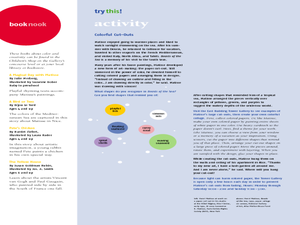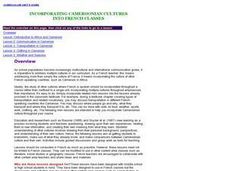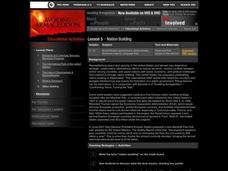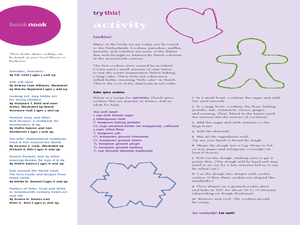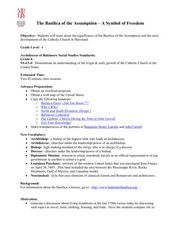Curated OER
Politics and Portraiture
Students examine the art of artists who use portrait drawing to make a political statement. For this art analysis lesson, students discuss the elements of a portrait and view the portraits as political expressions. Students complete...
Curated OER
Deciphering the Declaration of Independence
Students explore the textual meaning of the Declaration of Independence. In this Declaration of Independence lesson, students read and paraphrase the text of the document into modern-day language. Students also consider the meaning of...
Curated OER
Reading Comprehension 9-- First Day in Class
In this reading worksheet, students practice comprehension skills by reading a passage describing a young Portuguese woman's first lesson plan in her new English class. Students answer 20 questions about the story. This is intended for...
Curated OER
What about Continental Drift?
Fifth graders research the Continental Drift by researching for evidence of continental movement. The teaching explains the theory of plate tectonics and the Earth's magnetic field. They conclude the lesson plan by watching the video of...
Curated OER
Justice in America
Eleventh graders analyze primary sources for evidence of intent and purpose. In this American government lesson, 11th graders compose a one-page response explaining their understanding of "justice." Students read and examine quotes about...
Curated OER
Colorful Cut-Outs
Students examine the works of Claude Matisse. In this Matisse Art Lesson, students explore Beasts of the Sea to find recognizable shapes. Students visit the National Gallery to view Matisse artworks.
Curated OER
Rise of the Modern City
Students explore industrial design and photography with an emphasis on the history of Paris. In this modern art lesson, students analyze and discuss the images of modern city life in Paris and the Eiffel Tower. Students participate in a...
Curated OER
The Alien and Sedition Acts: Defining American Freedom
Eleventh graders explore the purpose of the Alien and Sedition Acts. In this US History lesson, 11th graders analyze primary source documents. Students write an essay using writing prompts.
Curated OER
Incorporating Cameroonian Cultures into French Classes
Students explore Cameroonian culture. In this French lesson, students participate in activities that require them to discover the ties between Cameroonian culture and French culture.
Curated OER
Nation Building
Learners explore the concept of nation building. In this diplomacy lesson, students research America's nation building efforts in Somalia, Haiti, the Balkans, Guatemala, Cuba, Vietnam, and Grenada. Learners share their findings and...
Curated OER
The Play's the Thing: The Drama of Cyrano de Bergerac
Students practice dramatic 'living' through various drama activities. In this drama lesson, students define drama, view examples of dramatic elements in Cyrano de Bergerac and Roxanne, define characterization within the dramas, study the...
Curated OER
Study Guide for Lelavision's Physical Music
Young scholars complete activities for physical music analysis. In this physical music lesson, students read the biography for Lelavision musical sculptures, complete a sound and motion activity, and a making music activity. Young...
Curated OER
Early Explorers
Fifth graders research European explorers. In this world history instructional activity, 5th graders will compare eight European explorers and identify important factual information about each. Students will be engaged...
Curated OER
A Moroccan Fairy Tale vs. European Folk/Fairy Tale
Second graders explore world geography by reading two different fairy tales. In this cultural storytelling lesson, 2nd graders read Snow White and the Seven Dwarves and the Moroccan story The Girl Who Lived with the Gazelles. Students...
Curated OER
Killing Fields
Students view a television program that explores people's perceptions and expectations in war prior to and after WWI. They discuss the effects of trench warfare and write a journal entry or short oral report reflecting on their...
Curated OER
Teaching A Tale of Two Cities
Ninth graders read "A Tale of Two Cities" by Charles Dickens. In groups, they analyze the opinions of various philosophers on the French Revoluion. To end the lesson, they take all the information gathered during their readings and...
Curated OER
Fantastic Facts
Fourth graders are introduced to expository texts. They dwell to formulate the comprehension and gain the main ideas. Students encounter explicit comprehension strategies to help them transition into this new type of text.
Curated OER
A Shot in the Backwoods of Pennsylvania Sets the World Afire
Students study the French and Indian War and examine the events that led to the conflict. In this political lesson students compare the important significance of this event and how the relationships were impacted.
Curated OER
Paintings of food
Students study and discuss the paintings of different foods. In this food lesson plan, students read about paintings that are of treats, banquets, feasts, arrangements, and more, and then make cookies.
Curated OER
Examples of Cameroonian Clothing
Students examine aspects of culture in Cameroon. In this Cameroon lesson, students view a slide show featuring indigenous Cameroonian clothing and respond to discussion questions.
Curated OER
The Basilica of the Assumption-A Symbol of Freedom
Fourth graders explore the importance of the Basilica of Assumption and the development of the Catholic Church in Maryland. In this social studies instructional activity, 4th graders discuss the Basilica of the Assumption and the...
Curated OER
Refugees' Experiences in Countries of Asylum: "What's in a name"?
Ninth graders examine the term stereotype. In this Current Events lesson, 9th graders analyze posters on racism. Students watch news reports on racism and stereotyping.
Curated OER
Great Britain vs. Europe
Fourth graders explore the reasons for the Industrial Revolution and its effects on France.
Curated OER
Graphing: Ocean Floor
Learners graph the ocean floor using given data. For this earth science lesson, students label different oceanic features on the map. They answer questions at the end of the lab.







